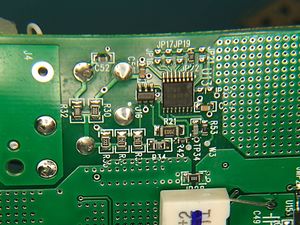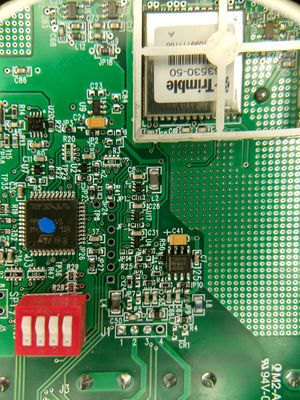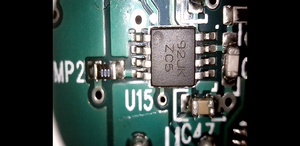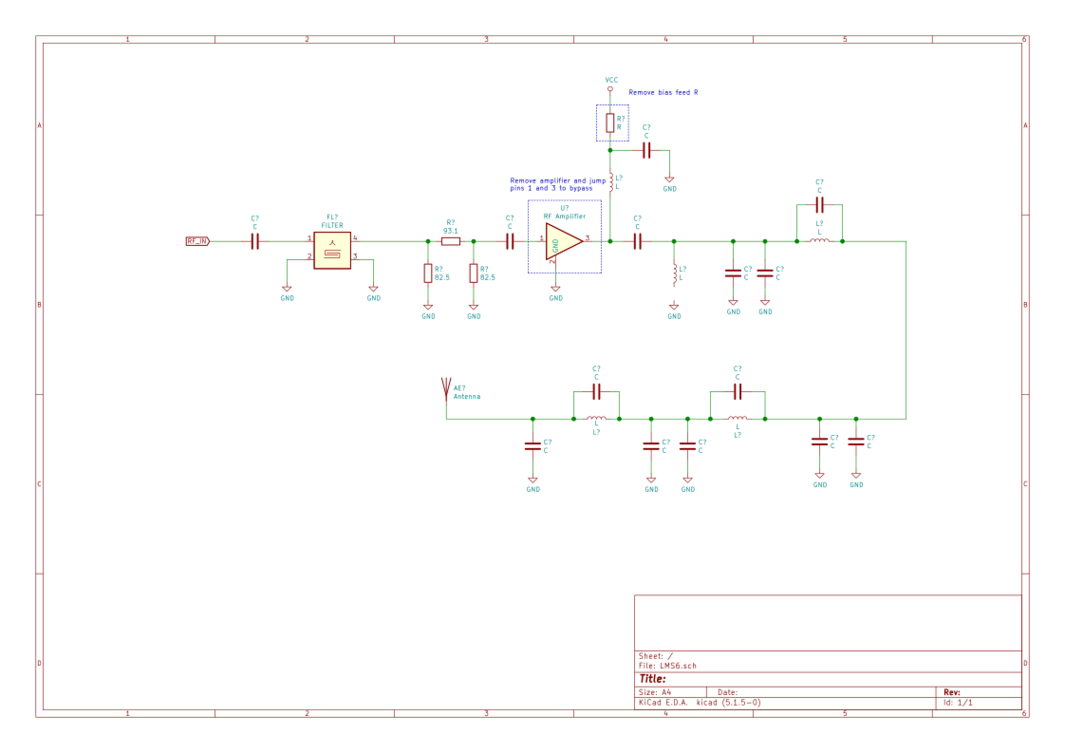Difference between revisions of "LMS-6 Radiosonde"
Paul Rixon (talk | contribs) (Added TX output schematic; instructions on how to disable amplifier.) |
(→Components: Props to N0RC for pointing out U15 is a 555. Updated.) |
||
| Line 281: | Line 281: | ||
U14 - [http://web.archive.org/web/20200214042837/http://www.ti.com/lit/ds/symlink/cd74hc4051.pdf CD74HC4051PWR] | U14 - [http://web.archive.org/web/20200214042837/http://www.ti.com/lit/ds/symlink/cd74hc4051.pdf CD74HC4051PWR] | ||
| − | U15 - | + | U15 - [https://www.ti.com/lit/ds/symlink/lmc555.pdf TI LMC555CMM Family] per the ZC5 marking noted in datasheet. Pinout and footprint matches. |
[[File:Screenshot 20200904-195417.png|thumb|92JK ZC5 chip noted as U15]] | [[File:Screenshot 20200904-195417.png|thumb|92JK ZC5 chip noted as U15]] | ||
{| class="wikitable" | {| class="wikitable" | ||
| Line 298: | Line 298: | ||
|- | |- | ||
|3 | |3 | ||
| − | | | + | |Trigger |
|Rounded square wave (maybe sawtooth) alternating between 2msec and 4msec, resting at +3VDC between bursts | |Rounded square wave (maybe sawtooth) alternating between 2msec and 4msec, resting at +3VDC between bursts | ||
|- | |- | ||
|4 | |4 | ||
| − | | | + | |Discharge |
|Rounded square wave alternating between 3msec and 5msec, short periods of 0v, resting at +3VDC between bursts | |Rounded square wave alternating between 3msec and 5msec, short periods of 0v, resting at +3VDC between bursts | ||
|- | |- | ||
|5 | |5 | ||
| − | | | + | |Output |
|Data. Square wave. 5V space, 0v mark? Pulses around 250msec per bit. | |Data. Square wave. 5V space, 0v mark? Pulses around 250msec per bit. | ||
|- | |- | ||
|6 | |6 | ||
| − | | | + | |Threshold |
|More rounded square wave bursts | |More rounded square wave bursts | ||
|- | |- | ||
|7 | |7 | ||
| − | | | + | |Reset |
| | | | ||
|- | |- | ||
|8 | |8 | ||
| − | | | + | |Control |
| | | | ||
|} | |} | ||
| Line 342: | Line 342: | ||
==Circuits== | ==Circuits== | ||
| − | === RF Transmitter Circuit === | + | ===RF Transmitter Circuit=== |
The transmitter RF path contains a filter IC, pi matching network, broadband amplifier, and a few more output filter stages. | The transmitter RF path contains a filter IC, pi matching network, broadband amplifier, and a few more output filter stages. | ||
[[File:LMS6.png|alt=Schematic diagram|center|frameless|1065x1065px|Basic schematic of TX circuit on LMS6]] | [[File:LMS6.png|alt=Schematic diagram|center|frameless|1065x1065px|Basic schematic of TX circuit on LMS6]] | ||
| Line 354: | Line 354: | ||
U16 -Input also has a cap to ground not shown on the sketch.<br /> | U16 -Input also has a cap to ground not shown on the sketch.<br /> | ||
| − | == Modifications == | + | ==Modifications== |
| − | === Disable amplification === | + | ===Disable amplification=== |
When testing, it's important not to transmit on unlicensed frequencies. Emissions can be eliminated by removing the RF amplifier from the chain and terminating the load at the antenna connection. The amplifier is an SOT-89 device just above the "-" terminal of B3. To access this RF chain, the shield housing may need to be temporarily removed. Also remove the bias feed resistor just below the "L104" marking. Then, remove the transmitter antenna from the "ANT1" connections. Use a 50 ohm resistor across the two terminals to provide a terminating load and eliminate any further transmission. Near-field reception is still possible after making these changes. | When testing, it's important not to transmit on unlicensed frequencies. Emissions can be eliminated by removing the RF amplifier from the chain and terminating the load at the antenna connection. The amplifier is an SOT-89 device just above the "-" terminal of B3. To access this RF chain, the shield housing may need to be temporarily removed. Also remove the bias feed resistor just below the "L104" marking. Then, remove the transmitter antenna from the "ANT1" connections. Use a 50 ohm resistor across the two terminals to provide a terminating load and eliminate any further transmission. Near-field reception is still possible after making these changes. | ||
Revision as of 21:55, 5 September 2020
The LMS-6 Radiosonde is a radiosonde manufactured by Lockheed-Martin Sippican, and used for meteorological sounding.
Contents
Overview
There are two models of the LMS-6, a 403MHz model and a 1680MHz model. This article will cover the 403MHz model unless specified.
Specs
- 16 Fixed transmit carrier frequencies (MHz): 400.250, 400.625, 401.000, 401.375, 401.750, 402.125, 402.500, 402.875, 403.250, 403.625, 404.000, 404.375, 404.750, 405.125, 405.500, 405.875
- Frequency tolerance +/-30ppm
- Mean TX Power 70.8mW (18.5dBm)
- Emission Designator 16K8F1D
- FSK with a maximum modulating frequency of 4.8 kHz
- Emission 3dB BW +/-5.0 kHz
- Emission 20dB BW +/-12.7 kHz
- Omnidirectional antenna
- Main beam gain 2dBi
- Horizontal Beamwidth 360 degrees
- Vertical Beamwidth +84 degrees
Source: https://apps.fcc.gov/els/GetAtt.html?id=121623&x=.
Photos
Connectors
There are four sensor connectors (SENSN) used for sensor input by the radiosonde. SENS1 is not populated on the 403MHz units. SENS2-4 have leads connected to them, and the sensors are connected to the other end of the leads, outside of the radiosonde housing. Only SENS1 appears to have spacing for a connector; the others have arbitrary lead spacing.
| Pin | Characteristics |
|---|---|
| 1 | +5V (5.47 measured) |
| 2 | GND? |
| 3 | +4.93V (Microcontroller VCC?) |
| 4 | 1 Hz |
| 5 | 1 Hz |
| 6 | 1 Hz |
| 7 | GND? |
Public information shows this header can be used for adding additional analog sensors to the radiosonde.
| Pin | Connection |
|---|---|
| 1 | Sensor pin 1 |
| 2 | Sensor pin 2 |
0.3" spacing. Both lead wires have ferrite beads immediately before connecting to the board.
| Pin | Connection |
|---|---|
| 1 | Sensor pin 1 |
| 2 | Sensor pin 2 |
0.5" spacing.
| Pin | Connection |
|---|---|
| 1 | Sensor pin 1 |
| 2 | Sensor pin 2 |
0.3" spacing. Fine gauge insulated wire run along SENS3 wire and loomed in white heat-shrink tubing.
| Pin Number | Function | Notes / Observations |
|---|---|---|
| 1,2,7,8 | U3 - Vdd | U15 - Pin 4 | |
| 9, 10, 15, 16, 19, 20, 33, 34 | Ground | |
| 2, 8, 18*, 24, 30 | +5VDC | 18 needs more research, may occasionally drop to ground? |
| 3 | U3 - ICCLK | TP33 | U21 - PCLK | |
| 4 | U3 - Vpp/ICCSEL | |
| 5 | U3 - RESET | |
| 6 | U3 - ICCDATA | |
| 11 | J5 - Pin 2 | |
| 12 | 3.3v - 2.5KHz square wave (4msec p/p) | |
| 13 | U3 - SW1.4 | |
| 17 | U3 - SW1.2 | |
| 18 | U3 - SW1.1 | |
| 23 | Rounded-square wave data bursts | |
| 26 | Rounded-square wave data bursts | |
| 31 | BATT POS | |
| 36 | U3 - SW1.3 | |
| 38 | U3 - OCMP1_A / AIN10 / PF4 | Square wave data bursts, 0.2msec per bit |
| 39 | RED WIRE | |
| 40 | Battery voltage | Around 9VDC measured |
| Pin | Wire Color | Use |
|---|---|---|
| 1 | Black | Ground |
| 2 | White | Battery +9 |
| 3 | Red | +9 VDC In |
| 4 | NC | Unknown - goes to
unpopulated CR1 |
J4 - NC - earphone jack? uses SENS3 leads
| Pin | Use |
|---|---|
| 1 | Unknown |
| 2 | Unknown |
| 3 | Unknown |
| 4 | Unknown |
These traces go to U3 (ST microcontroller)
| Pin | Use | Notes/Observations |
|---|---|---|
| 1 | +5VDC | |
| 2 | Unknown | 3V rounded square pulses, 2x per second, 2 different periods avg ~75msec? |
| 3 | +5VDC | |
| 4 | Unknown | 5V, 0.1msec pulse once per second |
| 5 | +5VDC | |
| 6 | Unknown | 5V, 0.1msec pulse once per second |
| 7 | +5VDC | |
| 8 | Unknown | 3V, 250msec pulse once per second |
These traces go to U14 (SPI mem?)
Components
GPS - Trimble 63530-50 s/n 1190122906
https://www.trimble.com/embeddedsystems/copernicus2.aspx
U3 - 72F324J6T6 - ST72324 - Main Microcontroller, ST7 series
U5, U6 - LP2985
U?? - TPS7201Q
U13 - CD4040BPW
U14 - CD74HC4051PWR
U15 - TI LMC555CMM Family per the ZC5 marking noted in datasheet. Pinout and footprint matches.
| U15 Pin | Function | Observations/Notes |
|---|---|---|
| 1 | GND | |
| 2 | 5VDC | |
| 3 | Trigger | Rounded square wave (maybe sawtooth) alternating between 2msec and 4msec, resting at +3VDC between bursts |
| 4 | Discharge | Rounded square wave alternating between 3msec and 5msec, short periods of 0v, resting at +3VDC between bursts |
| 5 | Output | Data. Square wave. 5V space, 0v mark? Pulses around 250msec per bit. |
| 6 | Threshold | More rounded square wave bursts |
| 7 | Reset | |
| 8 | Control |
U16 - LMV761
U21 - TI/Chipcon CC1050 (TSSOP 24)
U22 - TPS791
Sens 4 - Capacitive Relative humidity sensor
Notes
U13 Package marking shows CM040B. TI Park marking lookup provides CD4040BPW
U16 Package marking shows C22A. TI Part marking lookup provides LMV761. The SOT-23 footprint appears to match what is on the PCB.
Sens 4 is know to be capacitive since it is listed as such on page 13 of the WMO Common Code Tables Document
Circuits
RF Transmitter Circuit
The transmitter RF path contains a filter IC, pi matching network, broadband amplifier, and a few more output filter stages.
Relative Humidity Circuit
File:Relative Humidity Circuit Schematic.pdf
U16 -Input also has a cap to ground not shown on the sketch.
Modifications
Disable amplification
When testing, it's important not to transmit on unlicensed frequencies. Emissions can be eliminated by removing the RF amplifier from the chain and terminating the load at the antenna connection. The amplifier is an SOT-89 device just above the "-" terminal of B3. To access this RF chain, the shield housing may need to be temporarily removed. Also remove the bias feed resistor just below the "L104" marking. Then, remove the transmitter antenna from the "ANT1" connections. Use a 50 ohm resistor across the two terminals to provide a terminating load and eliminate any further transmission. Near-field reception is still possible after making these changes.



